英语介绍三苏祠苏轼
- 格式:ppt
- 大小:10.59 MB
- 文档页数:19
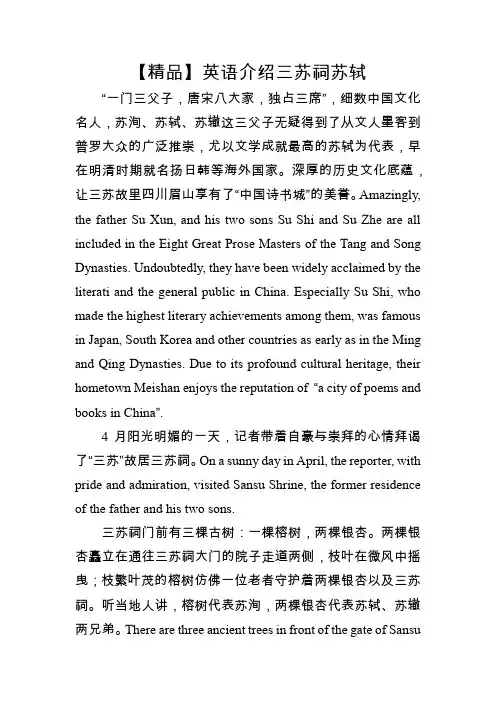
【精品】英语介绍三苏祠苏轼“一门三父子,唐宋八大家,独占三席”,细数中国文化名人,苏洵、苏轼、苏辙这三父子无疑得到了从文人墨客到普罗大众的广泛推崇,尤以文学成就最高的苏轼为代表,早在明清时期就名扬日韩等海外国家。
深厚的历史文化底蕴,让三苏故里四川眉山享有了“中国诗书城”的美誉。
Amazingly, the father Su Xun, and his two sons Su Shi and Su Zhe are all included in the Eight Great Prose Masters of the Tang and Song Dynasties. Undoubtedly, they have been widely acclaimed by the literati and the general public in China. Especially Su Shi, who made the highest literary achievements among them, was famous in Japan, South Korea and other countries as early as in the Ming and Qing Dynasties. Due to its profound cultural heritage, their hometown Meishan enjoys the reputation of “a city of poems and books in China”.4月阳光明媚的一天,记者带着自豪与崇拜的心情拜谒了“三苏”故居三苏祠。
On a sunny day in April, the reporter, with pride and admiration, visited Sansu Shrine, the former residence of the father and his two sons.三苏祠门前有三棵古树:一棵榕树,两棵银杏。
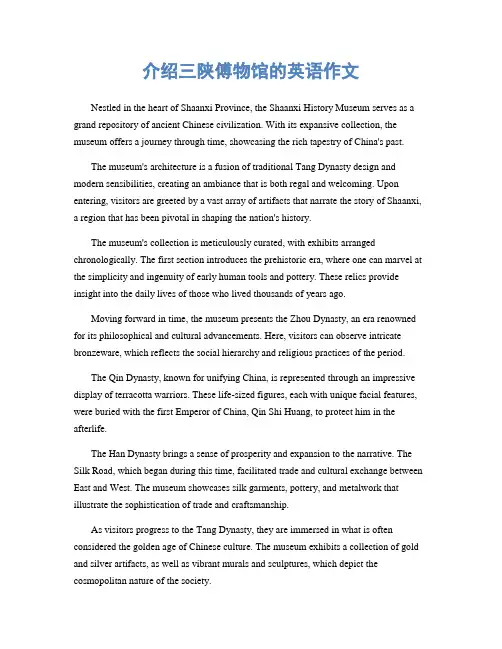
介绍三陕傅物馆的英语作文Nestled in the heart of Shaanxi Province, the Shaanxi History Museum serves as a grand repository of ancient Chinese civilization. With its expansive collection, the museum offers a journey through time, showcasing the rich tapestry of China's past.The museum's architecture is a fusion of traditional Tang Dynasty design and modern sensibilities, creating an ambiance that is both regal and welcoming. Upon entering, visitors are greeted by a vast array of artifacts that narrate the story of Shaanxi, a region that has been pivotal in shaping the nation's history.The museum's collection is meticulously curated, with exhibits arranged chronologically. The first section introduces the prehistoric era, where one can marvel at the simplicity and ingenuity of early human tools and pottery. These relics provide insight into the daily lives of those who lived thousands of years ago.Moving forward in time, the museum presents the Zhou Dynasty, an era renowned for its philosophical and cultural advancements. Here, visitors can observe intricate bronzeware, which reflects the social hierarchy and religious practices of the period.The Qin Dynasty, known for unifying China, is represented through an impressive display of terracotta warriors. These life-sized figures, each with unique facial features, were buried with the first Emperor of China, Qin Shi Huang, to protect him in the afterlife.The Han Dynasty brings a sense of prosperity and expansion to the narrative. The Silk Road, which began during this time, facilitated trade and cultural exchange between East and West. The museum showcases silk garments, pottery, and metalwork that illustrate the sophistication of trade and craftsmanship.As visitors progress to the Tang Dynasty, they are immersed in what is often considered the golden age of Chinese culture. The museum exhibits a collection of gold and silver artifacts, as well as vibrant murals and sculptures, which depict the cosmopolitan nature of the society.The museum does not merely display artifacts; it also offers interactive experiences. Through digital reconstructions and augmented reality, visitors can engage with history in a dynamic way, gaining a deeper understanding of the evolution of Chinese civilization.The Shaanxi History Museum is more than a collection of objects; it is a narrative woven with the threads of time. It stands as a testament to human achievement and a bridge connecting the past to the present. Through its doors, one can traverse centuries and emerge with a profound appreciation for the enduring legacy of China's history.In conclusion, the Shaanxi History Museum is an essential destination for anyone seeking to comprehend the breadth and depth of Chinese heritage. Its artifacts serve as silent narrators, each telling a story of triumph, innovation, and the indomitable human spirit. It is a place where history is preserved, honored, and continues to inspire. 。

三苏祠英文介绍简短English Answer:The Three Sus, or Su Shi, Su Zhe, and Su Xun, were renowned literary figures of the Song Dynasty (960-1279). Their ancestral home was in Meishan County, Sichuan Province, where the Three Sus Temple was built in their honor. The temple is a popular tourist destination and a key cultural relic site under national protection.The Three Sus Temple is located in the ancient town of Meishan, about two kilometers from the city center. The temple complex covers an area of over 30,000 square meters and consists of a series of halls, pavilions, and gardens.The main hall of the temple is dedicated to Su Shi, the most famous of the Three Sus. The hall houses a statue of Su Shi and displays his calligraphy and paintings. The other halls are dedicated to Su Zhe and Su Xun, and also house their works of art.In addition to the main halls, the temple complex also includes a number of other buildings, including a library,a museum, and a teahouse. The library houses a collectionof books and documents related to the Three Sus, while the museum displays artifacts from their lives. The teahouse is a popular spot for visitors to relax and enjoy a cup of tea.The Three Sus Temple is a beautiful and historic place that offers visitors a glimpse into the lives and works of three of China's most famous literary figures. The templeis a must-visit for anyone interested in Chinese history, culture, or literature.中文回答:三苏,即苏轼、苏辙、苏洵,是宋代著名的文学家。
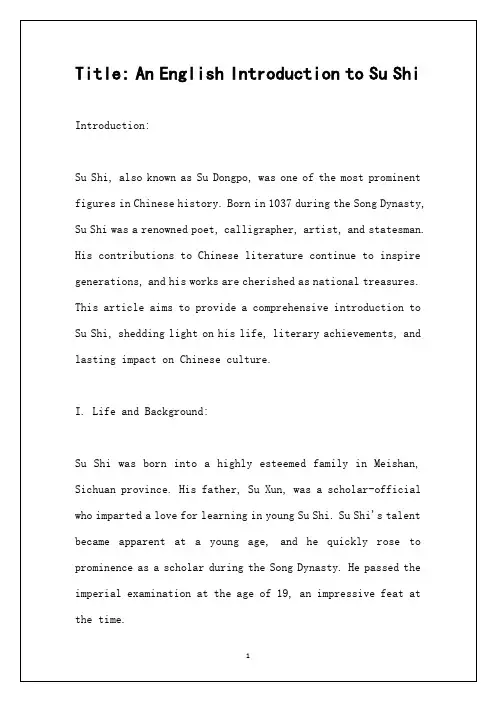
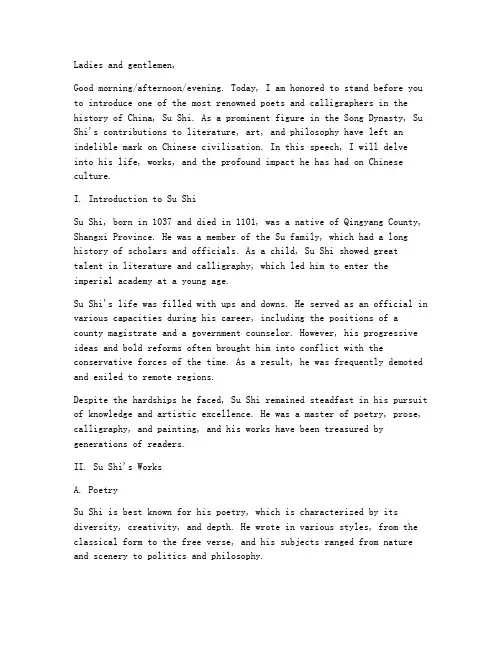
Ladies and gentlemen,Good morning/afternoon/evening. Today, I am honored to stand before you to introduce one of the most renowned poets and calligraphers in the history of China, Su Shi. As a prominent figure in the Song Dynasty, Su Shi's contributions to literature, art, and philosophy have left an indelible mark on Chinese civilization. In this speech, I will delveinto his life, works, and the profound impact he has had on Chinese culture.I. Introduction to Su ShiSu Shi, born in 1037 and died in 1101, was a native of Qingyang County, Shangxi Province. He was a member of the Su family, which had a long history of scholars and officials. As a child, Su Shi showed greattalent in literature and calligraphy, which led him to enter theimperial academy at a young age.Su Shi's life was filled with ups and downs. He served as an official in various capacities during his career, including the positions of a county magistrate and a government counselor. However, his progressive ideas and bold reforms often brought him into conflict with the conservative forces of the time. As a result, he was frequently demoted and exiled to remote regions.Despite the hardships he faced, Su Shi remained steadfast in his pursuit of knowledge and artistic excellence. He was a master of poetry, prose, calligraphy, and painting, and his works have been treasured by generations of readers.II. Su Shi's WorksA. PoetrySu Shi is best known for his poetry, which is characterized by its diversity, creativity, and depth. He wrote in various styles, from the classical form to the free verse, and his subjects ranged from nature and scenery to politics and philosophy.His poetry reflects his diverse experiences in life. In his early works, he celebrated the beauty of nature and the joys of friendship. In his later works, he expressed his disillusionment with the political world and his longing for peace and simplicity.B. ProseIn addition to poetry, Su Shi was also a master of prose. His essays and letters are known for their wit, elegance, and philosophical insights. He wrote about a wide range of topics, from the nature of art to the importance of friendship.C. Calligraphy and PaintingSu Shi was also a renowned calligrapher and painter. His calligraphy is known for its bold and expressive strokes, while his paintings often depict landscapes and flowers. He believed that calligraphy and painting were not just artistic endeavors but also a means to express one's inner world.III. Su Shi's Impact on Chinese CultureA. PoetrySu Shi's poetry has had a profound impact on Chinese literature. His works have inspired countless poets and writers throughout history. His innovative techniques and themes have been studied and emulated by many.B. Calligraphy and PaintingSu Shi's contributions to calligraphy and painting have also had alasting influence on Chinese art. His unique style has been emulated by countless calligraphers and painters, and his works continue to be revered today.C. PhilosophySu Shi's philosophy has also had a significant impact on Chinese thought. He believed in the importance of self-cultivation and the pursuit of inner peace. His ideas have been studied and discussed by scholars and philosophers for centuries.IV. ConclusionIn conclusion, Su Shi was a multifaceted genius whose contributions to Chinese culture have been immense. His poetry, prose, calligraphy, and painting have left an indelible mark on Chinese civilization. His works continue to inspire and delight readers around the world.As we reflect on Su Shi's life and achievements, we are reminded of the power of creativity and the importance of perseverance. His legacy serves as a testament to the enduring value of art and the pursuit of knowledge.Thank you for your attention.。
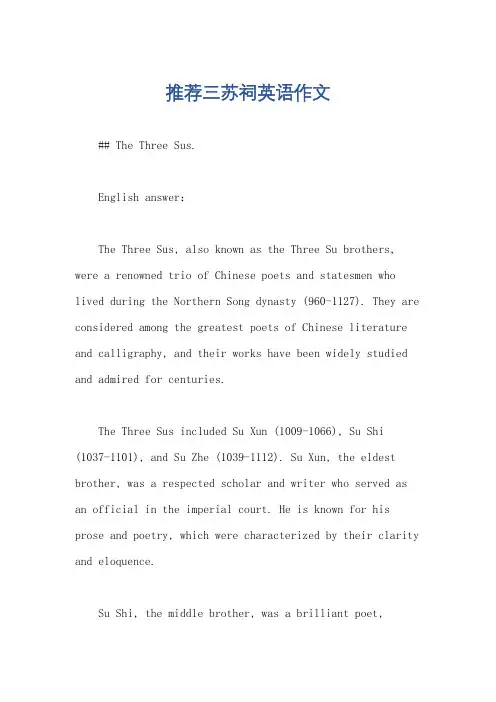
推荐三苏祠英语作文## The Three Sus.English answer:The Three Sus, also known as the Three Su brothers, were a renowned trio of Chinese poets and statesmen who lived during the Northern Song dynasty (960-1127). They are considered among the greatest poets of Chinese literature and calligraphy, and their works have been widely studied and admired for centuries.The Three Sus included Su Xun (1009-1066), Su Shi (1037-1101), and Su Zhe (1039-1112). Su Xun, the eldest brother, was a respected scholar and writer who served as an official in the imperial court. He is known for his prose and poetry, which were characterized by their clarity and eloquence.Su Shi, the middle brother, was a brilliant poet,calligrapher, and statesman. He was a high-ranking official in the government and was widely admired for his wit and political acumen. Su Shi is considered one of the greatest poets of Chinese literature, and his works are still widely read and studied today.Su Zhe, the youngest brother, was also a talented poet and writer. He served as an official in the imperial court and was known for his integrity and his devotion to his family. Su Zhe's works are less well-known than those ofhis brothers, but they are still highly regarded by scholars.The Three Sus were known for their close relationship and their mutual support of each other's literary endeavors. They often traveled and wrote poetry together, and they inspired and influenced each other's work. The Three Susare considered a shining example of the cultural andliterary achievements of the Northern Song dynasty.### Su Xun.Su Xun (1009-1066), the eldest of the Three Sus, was born in Meishan, Sichuan. He was a precocious child who began writing poetry at an early age. Su Xun studied the classics and passed the imperial examinations, becoming a jinshi degree holder in 1034.Su Xun served as an official in the imperial court and was known for his integrity and his deep understanding of the Confucian classics. He was a respected scholar and writer, and his prose and poetry were widely admired. Su Xun's works are characterized by their clarity, eloquence, and strong moral content.Su Xun's most famous work is his "Treatise on Classic Historiography" (Qian Xulun), which is considered a masterpiece of Chinese literary criticism. In this work, Su Xun argued that history should be written in a clear and concise style, and that it should focus on the moral lessons that can be learned from the past.Su Xun's writings had a profound influence on his sons, Su Shi and Su Zhe, who both became renowned poets andstatesmen. Su Xun is considered one of the founders of the Neo-Confucian movement, which emphasized the importance of ethical behavior and social responsibility.### Su Shi.Su Shi (1037-1101), the middle son of the Three Sus, was born in Meishan, Sichuan. He was a brilliant child who quickly mastered the classics and began writing poetry at an early age. Su Shi passed the imperial examinations and became a jinshi degree holder in 1057.Su Shi served as an official in the imperial court and was quickly promoted to high-ranking positions. He was known for his wit and political acumen, and he was widely admired by his peers. Su Shi was also a gifted poet and calligrapher, and his works are still widely read and studied today.Su Shi's poetry is characterized by its wit, humor, and deep understanding of human nature. He wrote on a wide range of topics, including nature, love, friendship, andpolitics. Su Shi's most famous works include his "Ode to the Red Cliff" (Chibi Fu) and his "Water Melody Song" (Shui Diao Ge Tou).Su Shi's calligraphy is also highly regarded, and he is considered one of the greatest calligraphers of Chinese history. His calligraphy is characterized by its strength, elegance, and freedom of expression.Su Shi was a controversial figure during his lifetime, and he was often criticized for his outspokenness and his unconventional behavior. He was twice banished from the imperial court, but he was eventually rehabilitated and restored to his former position.Su Shi is considered one of the greatest poets of Chinese literature, and he is still widely admired for his wit, talent, and integrity.### Su Zhe.Su Zhe (1039-1112), the youngest of the Three Sus, wasborn in Meishan, Sichuan. He was a gifted child who quickly mastered the classics and began writing poetry at an early age. Su Zhe passed the imperial examinations and became a jinshi degree holder in 1059.Su Zhe served as an official in the imperial court and was known for his integrity and his devotion to his family. He was a talented poet and writer, and his works are still highly regarded by scholars.Su Zhe's poetry is characterized by its simplicity, clarity, and deep understanding of human nature. He wroteon a wide range of topics, including nature, love, friendship, and politics. Su Zhe's most famous worksinclude his "Ode to the Lotus" (Lian Hua Fu) and his "Songof the Peach Blossom Spring" (Tao Hua Yuan Ji).Su Zhe was a devoted son and brother, and he oftenwrote poems about his family. He was also a loyal friend, and he often wrote poems about his friends and colleagues.Su Zhe was a less controversial figure than his brother,Su Shi, and he was generally admired by his peers. He served in a number of high-ranking positions in theimperial court, and he was eventually appointed as the Grand Tutor of the Heir Apparent.Su Zhe is considered a great poet and statesman, and he is still widely admired for his integrity, talent, and devotion to his family and friends.## Legacy.The Three Sus are considered among the greatest poets of Chinese literature, and their works have been widely studied and admired for centuries. They are known for their wit, their deep understanding of human nature, and their commitment to social responsibility. The Three Sus are a shining example of the cultural and literary achievements of the Northern Song dynasty.中文回答:### 三苏。
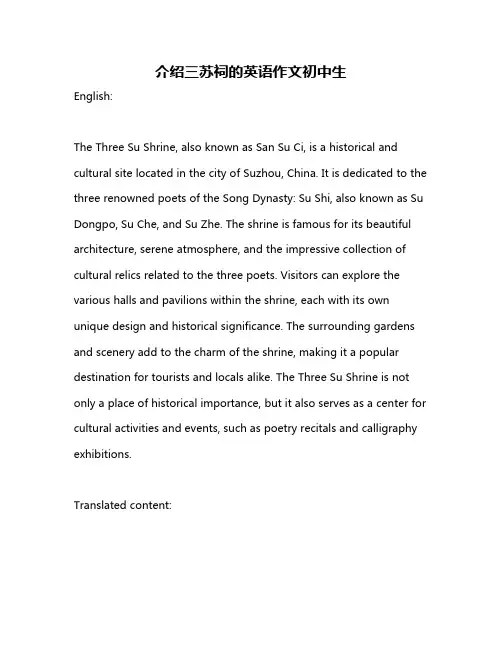
介绍三苏祠的英语作文初中生English:The Three Su Shrine, also known as San Su Ci, is a historical and cultural site located in the city of Suzhou, China. It is dedicated to the three renowned poets of the Song Dynasty: Su Shi, also known as Su Dongpo, Su Che, and Su Zhe. The shrine is famous for its beautiful architecture, serene atmosphere, and the impressive collection of cultural relics related to the three poets. Visitors can explore the various halls and pavilions within the shrine, each with its own unique design and historical significance. The surrounding gardens and scenery add to the charm of the shrine, making it a popular destination for tourists and locals alike. The Three Su Shrine is not only a place of historical importance, but it also serves as a center for cultural activities and events, such as poetry recitals and calligraphy exhibitions.Translated content:三苏祠,也被称为“三苏词”,是位于中国苏州市的一处历史文化景点。
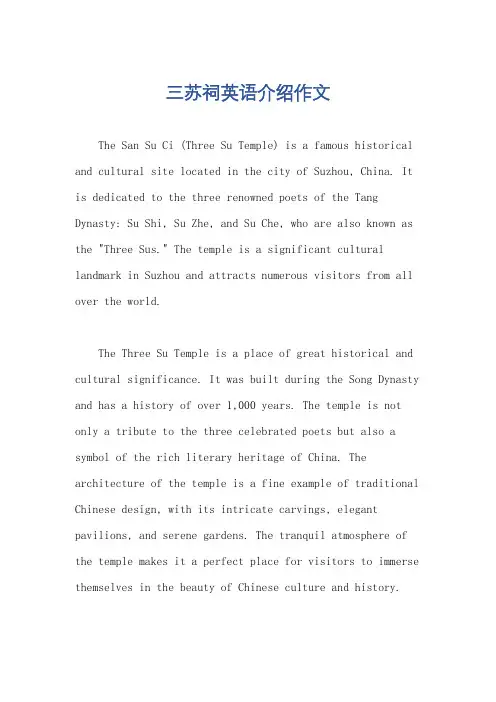
三苏祠英语介绍作文The San Su Ci (Three Su Temple) is a famous historical and cultural site located in the city of Suzhou, China. It is dedicated to the three renowned poets of the Tang Dynasty: Su Shi, Su Zhe, and Su Che, who are also known as the "Three Sus." The temple is a significant cultural landmark in Suzhou and attracts numerous visitors from all over the world.The Three Su Temple is a place of great historical and cultural significance. It was built during the Song Dynasty and has a history of over 1,000 years. The temple is not only a tribute to the three celebrated poets but also a symbol of the rich literary heritage of China. The architecture of the temple is a fine example of traditional Chinese design, with its intricate carvings, elegant pavilions, and serene gardens. The tranquil atmosphere of the temple makes it a perfect place for visitors to immerse themselves in the beauty of Chinese culture and history.One of the main attractions of the Three Su Temple is the collection of artifacts and relics related to the three poets. Visitors can see a wide range of cultural artifacts, including calligraphy, paintings, and personal belongingsof the poets. These artifacts provide a glimpse into the lives and works of the Three Sus, allowing visitors to gain a deeper understanding of their literary achievements and contributions to Chinese culture.In addition to its historical and cultural significance, the Three Su Temple also serves as a center for the promotion of Chinese literature and art. The temple hosts various cultural events, such as poetry recitals,calligraphy exhibitions, and traditional Chinese music performances. These events not only attract art enthusiasts and scholars but also provide an opportunity for visitorsto experience the beauty and elegance of traditional Chinese art forms.The Three Su Temple is not only a place of cultural significance but also a place of spiritual significance for many people. The tranquil and serene environment of thetemple provides a peaceful retreat for those seeking solace and spiritual reflection. Many visitors come to the temple to meditate, pray, or simply to find inner peace amidst the hustle and bustle of modern life.Visiting the Three Su Temple is a truly enriching and inspiring experience. It offers a unique opportunity to explore the rich literary heritage of China, appreciate traditional Chinese art and architecture, and find inner peace in a serene and spiritual environment. Whether you are a history enthusiast, an art lover, or simply someone seeking a peaceful retreat, the Three Su Temple is a must-visit destination that will leave a lasting impression on your heart and soul.。
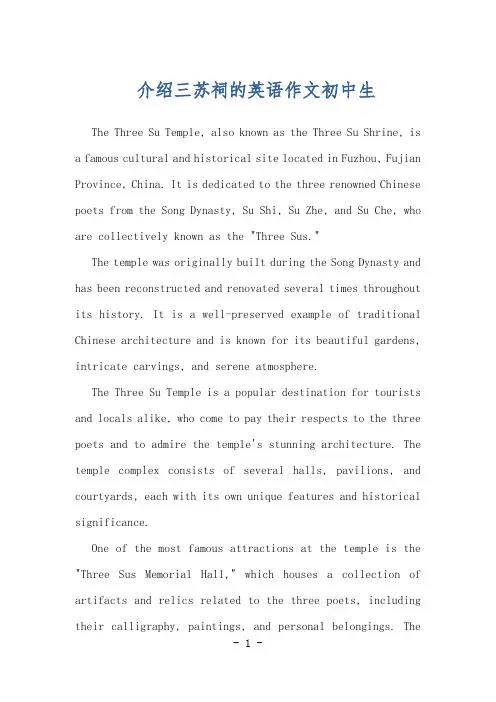
介绍三苏祠的英语作文初中生The Three Su Temple, also known as the Three Su Shrine, is a famous cultural and historical site located in Fuzhou, Fujian Province, China. It is dedicated to the three renowned Chinese poets from the Song Dynasty, Su Shi, Su Zhe, and Su Che, who are collectively known as the "Three Sus."The temple was originally built during the Song Dynasty and has been reconstructed and renovated several times throughout its history. It is a well-preserved example of traditional Chinese architecture and is known for its beautiful gardens, intricate carvings, and serene atmosphere.The Three Su Temple is a popular destination for tourists and locals alike, who come to pay their respects to the three poets and to admire the temple's stunning architecture. The temple complex consists of several halls, pavilions, and courtyards, each with its own unique features and historical significance.One of the most famous attractions at the temple is the "Three Sus Memorial Hall," which houses a collection of artifacts and relics related to the three poets, including their calligraphy, paintings, and personal belongings. Thehall also features a statue of the three poets, as well as inscriptions and poems written by them.In addition to the memorial hall, visitors can also explore the temple's other buildings, such as the "Lingyan Pavilion" and the "Yueyang Tower," which offer panoramic views of the surrounding landscape. The temple's gardens are also a highlight, with their lush vegetation, tranquil ponds, and traditional Chinese landscaping.Throughout the year, the temple hosts various cultural events and activities, including poetry readings, calligraphy exhibitions, and traditional Chinese music performances. These events provide visitors with a deeper understanding of the Three Sus' literary and cultural contributions.Overall, the Three Su Temple is not only a place of worship and remembrance but also a living testament to the enduring legacy of the Three Sus and their impact on Chinese literature and culture.三苏祠,又称三苏祠堂,是位于中国福建省福州市的一处著名的文化历史遗址。
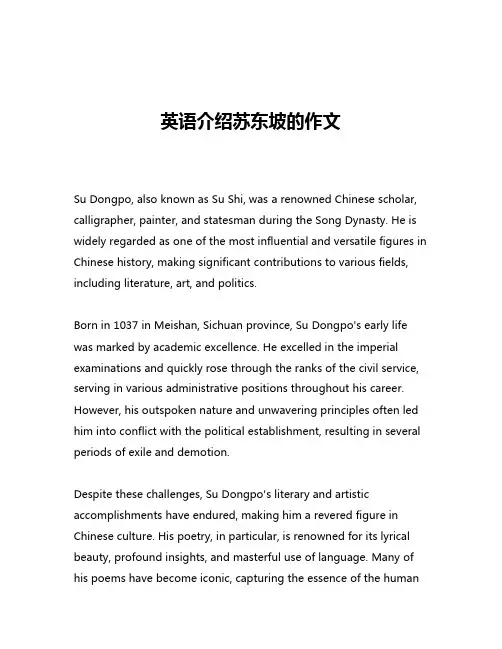
英语介绍苏东坡的作文Su Dongpo, also known as Su Shi, was a renowned Chinese scholar, calligrapher, painter, and statesman during the Song Dynasty. He is widely regarded as one of the most influential and versatile figures in Chinese history, making significant contributions to various fields, including literature, art, and politics.Born in 1037 in Meishan, Sichuan province, Su Dongpo's early life was marked by academic excellence. He excelled in the imperial examinations and quickly rose through the ranks of the civil service, serving in various administrative positions throughout his career. However, his outspoken nature and unwavering principles often led him into conflict with the political establishment, resulting in several periods of exile and demotion.Despite these challenges, Su Dongpo's literary and artistic accomplishments have endured, making him a revered figure in Chinese culture. His poetry, in particular, is renowned for its lyrical beauty, profound insights, and masterful use of language. Many of his poems have become iconic, capturing the essence of the humanexperience and reflecting on themes such as nature, love, and the human condition.One of Su Dongpo's most celebrated works is his "Ode to the Red Cliff," a poetic masterpiece that describes a scenic location along the Yangtze River. In this poem, Su Dongpo skillfully weaves together vivid imagery, philosophical reflections, and historical allusions, creating a profound meditation on the transience of life and the enduring power of the natural world. The poem has become a beloved classic, inspiring generations of readers and artists.Beyond his literary achievements, Su Dongpo was also a renowned calligrapher and painter. His calligraphic style was highly influential, characterized by a bold and expressive brushwork that conveyed a sense of spontaneity and emotional depth. Similarly, his paintings often depicted landscapes and scenes from nature, reflecting his deep appreciation for the natural world and his desire to capture its essence on the canvas.In the realm of politics, Su Dongpo's legacy is equally significant. He served as a high-ranking official in the Song Dynasty government, and his progressive reforms and unwavering commitment to justice earned him the respect and admiration of many. However, his outspoken criticism of corruption and his willingness to challenge the status quo also made him a target of political opponents, leadingto his frequent dismissal and exile.Despite these setbacks, Su Dongpo remained steadfast in his principles and continued to advocate for social and political reforms. His writings and public speeches often addressed issues of good governance, the role of the individual in society, and the importance of upholding moral and ethical standards.One of the most remarkable aspects of Su Dongpo's life was his ability to maintain a sense of equanimity and inner peace even in the face of adversity. He was known for his philosophical outlook, which emphasized the importance of finding contentment and balance in all aspects of life. This philosophy is reflected in his writings, which often explore themes of detachment, acceptance, and the pursuit of a life in harmony with the natural world.Throughout his life, Su Dongpo's influence extended far beyond the borders of China, inspiring artists, scholars, and thinkers across Asia and beyond. His works have been translated into numerous languages, and his legacy continues to be celebrated and studied by scholars and enthusiasts around the world.Today, Su Dongpo's name is synonymous with the rich cultural heritage of China, and his contributions to the arts, literature, and political thought continue to be revered and studied by people of allbackgrounds. His life and work serve as a testament to the enduring power of the human spirit and the transformative potential of creativity, intellect, and moral courage.。
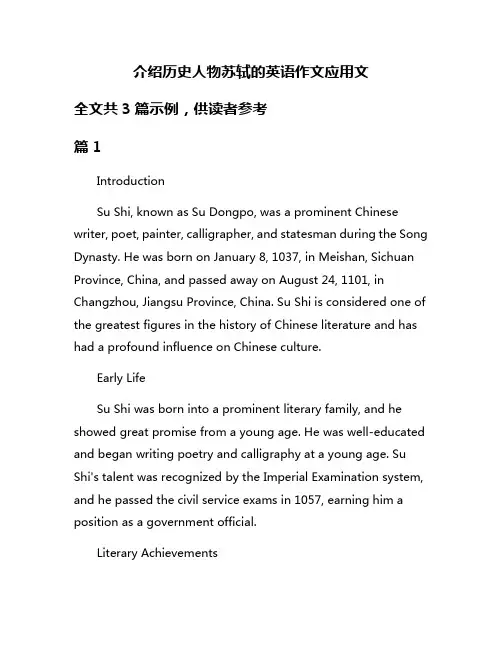
介绍历史人物苏轼的英语作文应用文全文共3篇示例,供读者参考篇1IntroductionSu Shi, known as Su Dongpo, was a prominent Chinese writer, poet, painter, calligrapher, and statesman during the Song Dynasty. He was born on January 8, 1037, in Meishan, Sichuan Province, China, and passed away on August 24, 1101, in Changzhou, Jiangsu Province, China. Su Shi is considered one of the greatest figures in the history of Chinese literature and has had a profound influence on Chinese culture.Early LifeSu Shi was born into a prominent literary family, and he showed great promise from a young age. He was well-educated and began writing poetry and calligraphy at a young age. Su Shi's talent was recognized by the Imperial Examination system, and he passed the civil service exams in 1057, earning him a position as a government official.Literary AchievementsSu Shi was a prolific writer and is best known for his poetry. His poems are characterized by their elegance, simplicity, and emotional depth. Su Shi's poetry often explored themes of nature, love, and morality, and his work is still highly regarded in China today. In addition to his poetry, Su Shi was also a skilled calligrapher and painter. He was known for his unique artistic style, which combined traditional Chinese techniques with his own innovative approach.Political CareerThroughout his life, Su Shi held various government positions, including that of a magistrate and a governor. However, his outspoken and rebellious nature often clashed with the authorities, leading to several periods of exile and imprisonment. Despite these setbacks, Su Shi remained dedicated to public service and continued to advocate for political reform.LegacySu Shi's influence extends far beyond his own lifetime. His poetry and writings have inspired generations of Chinese scholars and artists, and his name is synonymous with literary excellence in China. Su Shi's work continues to be studied andcelebrated around the world, and he is considered one of the greatest Chinese poets of all time.ConclusionSu Shi's life and work are a testament to the power of art and literature to transcend time and space. His poetry and writings have touched the hearts of countless people, and his legacy will continue to inspire future generations for years to come. Su Shi's contributions to Chinese culture are immeasurable, and his name will forever be remembered as a symbol of creativity, passion, and resilience.篇2Introduction to the Historical Figure Su ShiSu Shi, also known as Su Dongpo, was a prominent Chinese writer, poet, painter, calligrapher, pharmacologist, and statesman during the Song Dynasty. He was born on January 8, 1037, in Meishan, Sichuan, China, and died on August 24, 1101, in Changsha, Hunan, China. Su Shi's contributions to Chinese literature and culture are vast and enduring, making him one of the most celebrated figures in Chinese history.Su Shi was a versatile and prolific writer, known for his poetry, essays, and prose. His poetry often reflected hisobservations of nature, his emotions, and his personal experiences. One of his most famous poems is "Ode to the Red Cliff," which describes the famous battle of Red Cliff during the Three Kingdoms period. Su Shi's essays and prose were also highly regarded for their wit, humor, and insight into human nature.In addition to his literary accomplishments, Su Shi was also a talented painter and calligrapher. He was known for his bold brushwork and expressive style, which combined traditional Chinese painting techniques with a more innovative and individualistic approach. Su Shi's paintings often featured landscapes, birds, flowers, and animals, reflecting his love of nature and his deep connection to the world around him.Su Shi's impact on Chinese culture extended beyond his artistic and literary achievements. He was also a prominent statesman, serving as an official in the imperial government under the Song Dynasty. Su Shi was known for his integrity, honesty, and dedication to public service, earning him the respect and admiration of his peers and the common people.Despite facing political persecution and exile at various points in his life, Su Shi remained steadfast in his beliefs and continued to produce a rich body of work that has stood the testof time. His legacy as a scholar, artist, and statesman continues to inspire generations of Chinese people and readers around the world.In conclusion, Su Shi was a remarkable figure in Chinese history, whose contributions to literature, art, and culture continue to be revered and celebrated to this day. His enduring legacy serves as a testament to the power of creativity, intellect, and perseverance in the face of adversity.篇3Introduction to the Historical Figure Su ShiSu Shi, also known as Su Dongpo, was a prominent Chinese writer, poet, painter, calligrapher, and statesman during the Song Dynasty. He was born in Meishan, Sichuan province in 1037 and passed away in 1101.Su Shi is renowned for his literary talents and contributions to Chinese literature. He was a master poet, with many of his works still being admired and studied today. His poems are known for their vivid imagery, emotional depth, and romantic themes. One of his most famous poems is "Red Cliff," which depicts the historical battle at Red Cliffs and reflects on the ephemeral nature of life.In addition to his poetry, Su Shi was also a skilled calligrapher and painter. He developed his own unique style of calligraphy, known as "Su-style calligraphy," which was characterized by its fluidity and elegance. He was also an accomplished painter, with his works often featuring landscapes, flowers, and birds.Su Shi was not only a talented artist but also a prominent statesman. He served as an official in the Song Dynasty government, holding various positions throughout his career. Despite facing political setbacks and exile, Su Shi remained dedicated to his beliefs and principles, often speaking out against corruption and injustice.Overall, Su Shi was a multi-talented individual whose contributions to Chinese literature, art, and politics have left a lasting impact on Chinese culture. He is remembered as one of the greatest literary figures in Chinese history and continues to be revered for his creativity, intellect, and integrity.。
介绍历史人物苏轼的英语作文应用文全文共10篇示例,供读者参考篇1Hi everyone! Today I want to introduce a famous historical figure named Su Shi in English. Su Shi, also known as Su Dongpo, was a renowned Chinese writer, poet, painter, calligrapher, and statesman during the Song Dynasty.Su Shi was born in 1037 in Meishan, Sichuan Province, China. He came from a literary family and was highly talented in writing from a young age. Su Shi's poetry is known for its depth, emotional resonance, and vivid imagery. He wrote about a wide range of topics, including nature, love, politics, and philosophical reflections.In addition to his literary accomplishments, Su Shi was also a skilled calligrapher and painter. His calligraphy is considered one of the most important in Chinese art history, and his paintings often depict scenes from nature, such as birds, flowers, and landscapes.Su Shi was also a prominent government official and served in various positions throughout his career. He was known for hisintegrity, honesty, and dedication to serving the people. Su Shi was a reformer who advocated for social justice and political transparency.Throughout his life, Su Shi faced many hardships, including political persecution and exile. Despite these challenges, he remained optimistic and continued to create beautiful art and poetry that inspired generations of Chinese people.In conclusion, Su Shi was a multifaceted talent who made significant contributions to Chinese literature, art, and politics. His legacy continues to inspire and influence people around the world today. Thank you for listening to my introduction of this amazing historical figure!篇2Sure, I can help you write an English essay introducing the historical figure Su Shi (also known as Su Dongpo) in a child-like and informal style. Here is the essay:Hi everyone! Today, I want to tell you about a super cool dude from the olden times named Su Shi. But you can also call him Su Dongpo if you want to be fancy! Su Shi was a famous Chinese writer, poet, painter, calligrapher, and statesman during the Song Dynasty. He was like a superstar back then!Su Shi was born in 1037 in Meishan, Sichuan Province, China. He loved reading and writing since he was a little kid. His dad was also a scholar, so he must have passed on the smart genes to Su Shi!One of the coolest things about Su Shi is that he was a master of so many talents. He wrote beautiful poems that touched people's hearts, and his calligraphy was so awesome that it was like a work of art. He even painted amazing pictures of mountains and rivers!But Su Shi wasn't just about art and poetry. He was also a government official and wanted to help make the world a better place. He worked hard to fight corruption and improve the lives of ordinary people. What a nice guy!One of Su Shi's most famous quotes is "When you can do what you enjoy, you will never work a day in your life". Isn't that a cool thing to say? It means that if you find something you love to do, it won't feel like work at all!So, that's a little bit about Su Shi, the awesome dude from ancient China. He was a talented writer, poet, artist, and a caring government official. He showed us that it's important to follow our passions and work hard to make the world a better place. Go Su Shi!篇3Sure! Here is a child-friendly introduction to the historical figure Su Shi:Hey everyone! Today I want to talk about a really cool guy from a long time ago named Su Shi. He was a super famous poet and calligrapher in ancient China. People also call him Su Dongpo because he was so awesome!Su Shi was born in 1037 and he lived during the Song Dynasty. He wrote lots of beautiful poems that people still read today. He also loved to paint and do calligraphy. He was like a superstar artist back then!But Su Shi wasn't just about art. He was also a really smart guy. He passed the highest level of the imperial exams and became a government official. He even worked as a governor in different places. He was super talented and everyone loved him!One really cool thing about Su Shi was that he wasn't afraid to speak his mind. He wrote a lot of essays criticizing the government and talking about how to make the country better. Some people didn't like what he said, but he didn't care. He just wanted to make things right.Sadly, Su Shi had to go through some tough times too. He was sent to prison a few times because of his ideas. But that didn't stop him from writing and painting. He kept on creating amazing art until the end of his life.Even though Su Shi lived a long time ago, his poems and paintings are still loved by people all over the world. He was a true genius and a really special person. So next time you read one of Su Shi's poems, remember how awesome he was! Thanks for listening!篇4Hi everyone, I want to introduce a famous historical figure named Su Shi, also known as Su Dongpo. He was a great writer, poet, painter, calligrapher, and statesman in ancient China. Su Shi lived during the Song Dynasty, from 1037 to 1101.Su Shi was famous for his poetry, which was known for its beauty and emotional depth. One of his most famous poems is "Prelude to Water Melody," which describes the beauty of nature and the passing of time. He also wrote many essays on a wide range of topics, such as politics, history, and philosophy.In addition to his writing, Su Shi was also a talented painter and calligrapher. He created many beautiful paintings andcalligraphy pieces, which are still admired today for their skill and creativity.Su Shi was not only a great artist, but also a respected statesman. He served as a government official in different regions of China, where he worked to improve the lives of the people and promote justice and fairness.Overall, Su Shi was a multi-talented and influential figure in Chinese history. His legacy continues to inspire people around the world, and his works are still studied and enjoyed by many. So, let's continue to appreciate and learn from the great Su Shi!篇5Hello everyone, today I want to introduce a very cool historical figure to you guys, his name is Su Shi, also known as Su Dongpo. He lived in China over a thousand years ago during the Song Dynasty. He was a famous poet, writer, calligrapher, painter, and statesman.Su Shi was born in a scholarly family and he started writing poetry at a very young age. His poems are very famous for their beauty and emotion. He wrote about nature, love, politics, andhis own feelings. One of his most famous poems is "Red Cliff", which tells the story of a battle and the beauty of nature.Besides being a great poet, Su Shi was also a talented calligrapher. His calligraphy was praised for its beauty and elegance. He also liked to paint and his paintings often showed scenes of nature or animals.Su Shi was also a very smart and wise man. He worked as a government official and tried to make things better for the people. He was known for his honesty and courage in standing up for what he believed in.In conclusion, Su Shi was a multi-talented and admirable person in Chinese history. His works in poetry, calligraphy, painting, and as a statesman have left a lasting impact on Chinese culture. We can all learn from his creativity, wisdom, and dedication to his craft. Thank you for listening to my introduction of Su Shi, I hope you enjoyed it!篇6Title: Introduction to Historical Figure Su ShiHi everyone! Today I want to introduce you to a very famous historical figure in China, Su Shi. He was a super cool dude who lived during the Song Dynasty. Let's learn more about him!Su Shi was born in 1037 in Meishan, Sichuan Province. He was not only a poet but also a painter, calligrapher, and statesman. He was really good at writing poems and essays, and his works are still loved by people today. Su Shi was also known for being a great thinker and political reformer. He had a strong sense of justice and wanted to help make the world a better place.One of Su Shi's most famous poems is "Red Cliff." It's about a battle that happened during the Three Kingdoms period in Chinese history. His poems are full of emotion and beautiful descriptions of nature. Su Shi loved to write about his feelings and thoughts, and many people admire his honesty and sincerity.In addition to being a poet, Su Shi was also a talented painter and calligrapher. He loved to express himself through art, and his works are still treasured today. Su Shi was also a government official and served in various positions throughout his life. He believed in serving the people and working for the common good.Su Shi was a kind and generous person who always helped others in need. He was loved by many people for his humility and compassion. Even today, people respect and admire Su Shi for his contributions to Chinese culture and society.In conclusion, Su Shi was a remarkable historical figure who left a lasting legacy. He was a talented poet, painter, calligrapher, and statesman who cared about people and society. We can all learn from his example and strive to make a positive impact on the world, just like Su Shi did. Thank you for listening!篇7Hi everyone! Today I want to introduce a famous historical figure to you, Su Shi, also known as Su Dongpo. Su Shi was a great writer, poet, painter, calligrapher, and statesman in ancient China.Su Shi was born in 1037 in Meishan, Sichuan province. He was very talented and started writing poems at a young age. His poems were very popular and he became known as one of the "Eight Masters of the Tang and Song," a group of famous poets in Chinese history.Not only was Su Shi a great poet, but he was also a skilled calligrapher and painter. His calligraphy was very famous and heeven invented a new style called "Su Shi style." His paintings were also very unique and he was known for his landscapes and bamboo paintings.In addition to his artistic talents, Su Shi was also a respected statesman. He held many government positions and worked hard to improve the lives of the people. He was known for being honest, fair, and caring.Su Shi's life was full of ups and downs. He was exiled several times for criticizing the government, but he always remained dedicated to his work and his country. Despite his hardships, he continued to write beautiful poems and create amazing artworks.Su Shi's legacy still lives on today. His poems are still read and loved by many people, and his calligraphy and paintings are displayed in museums around the world. He is truly a legendary figure in Chinese history.In conclusion, Su Shi was a multi-talented and influential figure in ancient China. His poems, calligraphy, paintings, and government work have left a lasting impact on Chinese culture. Let's remember and honor this great historical figure, Su Shi!篇8Hello everyone! Today I am going to introduce a really cool historical figure, Su Shi, also known as Su Dongpo. He was a famous Chinese writer, poet, painter, calligrapher, and statesman during the Song dynasty.Su Shi was born in 1037 in Meishan, Sichuan Province, China. He came from a prominent family and received a top-notch education. He had a deep love for poetry and literature from a young age, and his writings were highly praised by his teachers and peers.One of Su Shi's most famous works is the "Red Cliff Ode," a poem that describes a famous battle in Chinese history. He was also known for his beautiful calligraphy and painting skills. Su Shi believed in the importance of social responsibility and justice, and he often used his writing to comment on political and social issues of his time.In addition to his artistic talents, Su Shi also had a successful political career. He held various government positions and was admired for his honesty, integrity, and dedication to serving the people.Despite facing some political setbacks and being exiled several times, Su Shi never gave up on his passion for writing and art. He continued to create masterpieces until his death in 1101.Su Shi's legacy continues to inspire people around the world today. His contributions to Chinese literature and art are truly remarkable, and his teachings on integrity and social responsibility are still relevant in modern society.So, let's all remember and celebrate the life and achievements of Su Shi, a true legend in Chinese history! Thank you for listening!篇9Title: Get to Know Su ShiHey everyone, do you know who Su Shi is? Let me tell you all about this amazing historical figure!Su Shi, also known as Su Dongpo, was a famous writer, poet, painter, calligrapher, and statesman in ancient China. Some people even call him a genius because he was so talented in so many different things!Su Shi was born in 1037 in Meishan, Sichuan province. He was very smart and started writing poems when he was just a kid. His poems were so good that everyone loved them! He wrote about nature, love, and even politics.Not only was Su Shi a great poet, but he was also a skilled painter and calligrapher. He loved to paint beautiful landscapes and write calligraphy that was so elegant and artistic. People would pay lots of money just to have one of his paintings!Besides being an artist, Su Shi was also a government official. He worked hard to make life better for the people and was loved by many for his honesty and kindness.One of Su Shi's most famous works is the "Red Cliff Ode." It is a poem that tells the story of a battle and has been loved by people for centuries. Su Shi's words are so powerful and emotional that they can make you feel like you are right there in the middle of the battle!Even though Su Shi lived over a thousand years ago, his works are still read and admired by people all over the world. He is a true inspiration to us all, showing us that with hard work and passion, we can achieve anything!So, now that you know all about Su Shi, do you want to read some of his poems or see his beautiful paintings? I'm sure you'll be amazed by his talent, just like I am!篇10Hello everyone! Today I want to introduce a famous historical figure named Su Shi.Su Shi, also known as Su Dongpo, was a prominent Chinese writer, poet, painter, calligrapher, pharmacologist, and statesman during the Song dynasty. He was born in 1037 and died in 1101. Su Shi was one of the most important figures in Chinese literature and history.Su Shi was known for his wit, intelligence, and creativity. He wrote over 2,500 poems, many of which are still well-known today. Some of his most famous works include "Red Cliff Ode," "Second Order to Yangzi Huzhou After Passing Jinjiang," and "Memories of the Capital."Su Shi was also a talented calligrapher and painter. His calligraphy was known for its elegance and grace, while his paintings were praised for their beauty and skill. He was also a skilled pharmacologist, and he made important contributions to the study of medicine during his time.In addition to his artistic talents, Su Shi was also a respected statesman. He held various official positions throughout his life and was known for his integrity and dedication to serving the people.Overall, Su Shi was a truly remarkable figure in Chinese history. His contributions to literature, art, medicine, and politics have left a lasting impact on Chinese culture and society. Let's all remember and appreciate the legacy of this great historical figure, Su Shi!。
三苏祠英语介绍作文San Su Ci is a famous temple located in Suzhou, China, which is dedicated to the three renowned Chinese poets Su Dongpo, Su Che, and Su Zhe. 三苏祠是一座位于中国苏州的著名寺庙,供奉着三位著名的中国诗人苏东坡、苏轼和苏辙。
This historical site was established during the Southern Song Dynasty and has since become a popular tourist destination for visitors from both China and abroad. 这座历史遗址建立于南宋时期,如今已成为来自中国和国外的游客热门旅游目的地。
One of the main attractions of San Su Ci is the exquisite architecture, which blends traditional Chinese design with intricate carvings and elegant landscaping. 三苏祠的一个主要景点是精致的建筑,融合了传统的中国设计和精美的雕刻与优雅的园林景观。
Visitors can explore the temple grounds and admire the intricate details of the pavilions, halls, and courtyards that make up this historic site. 游客们可以探索寺庙的庙宇和庭院,欣赏构成这一历史遗址的亭台楼阁和院落的精巧细节。
In addition to its architectural beauty, San Su Ci is also known for its cultural significance as a place dedicated to honoring the literary accomplishments of the three Su poets. 除了其建筑之美,三苏祠还以其文化意义而闻名,作为一个致力于纪念三位苏诗人文学成就的场所。
[Your Address][City, State, Zip Code][Email Address][Phone Number][Date][Recipient's Name][Recipient's Title][Recipient's Organization][Recipient's Address][City, State, Zip Code]Dear [Recipient's Name],I am writing to introduce to you one of the most prominent figures in Chinese history, the renowned poet, calligrapher, and politician, Su Shi, also known as Su Dongpo. His contributions to Chinese literature, art, and culture are immeasurable, and I believe his legacy holds significant value for our mutual understanding and appreciation of Chinese heritage.Personal BackgroundSu Shi, born on January 8, 1037, in Meishan, Sichuan Province, was a man of many talents. He was the son of Su Xun, a government official, andthe younger brother of Su Zhe, who was also a noted poet and politician. Together with his father and brother, they were known as the "Three Sus" in Chinese history.Literary and Artistic AchievementsSu Shi's literary career began at a young age, and he quickly gained recognition for his exceptional talent. His works, spanning poetry, prose, and calligraphy, have left an indelible mark on Chineseliterature.1. Poetry: Su Shi is best known for his poetry, which is characterizedby its vivid imagery, innovative structure, and profound emotional depth. His poetry often reflects his personal experiences, political views, and philosophical insights. Some of his most famous poems include "Quiet Night Thoughts" and "The Nightingale".2. Prose: In addition to poetry, Su Shi was also a master of prose. His essays, letters, and commentaries are notable for their wit, insight,and eloquence. His prose often served as a platform for his political views and social commentary.3. Calligraphy: Su Shi was a master calligrapher, known for his unique and bold style. His calligraphy is celebrated for its artistic beautyand technical skill, and it has had a lasting influence on Chinese calligraphy.Political CareerSu Shi's political career was marked by both success and adversity. He served in various government positions throughout his life, including as a prefect of several cities and as a member of the central government. However, his political views often clashed with those of the ruling class, leading to several periods of exile and hardship.Philosophical BeliefsSu Shi's philosophical beliefs were deeply influenced by Taoism, Buddhism, and Confucianism. He believed in the importance of self-cultivation, the pursuit of wisdom, and the harmony between humanity and nature. His philosophy is evident in his literary and artistic works, as well as in his personal life.Legacy and ImpactSu Shi's legacy is enduring, and his works continue to inspire and influence Chinese artists, writers, and thinkers to this day. His poetry and prose are studied in schools across China, and his calligraphy is celebrated as a pinnacle of artistic achievement. Moreover, his life andworks have become symbols of resilience, creativity, and the pursuit of knowledge.Why Introduce Su ShiIntroducing Su Shi is not only an opportunity to appreciate his remarkable achievements but also to understand the depth and diversity of Chinese culture. His life and works provide a window into the complexities of ancient Chinese society, politics, and thought. By studying Su Shi, we can gain valuable insights into the rich tapestry of Chinese history and the timeless values that continue to resonate with us today.In conclusion, I highly recommend that you consider including Su Shi in your study of Chinese history and culture. His life and works offer a profound and inspiring perspective on what it means to be human and to strive for excellence in all aspects of life.Thank you for considering this introduction. I look forward to the opportunity to discuss Su Shi's legacy further.Sincerely,[Your Name][Your Position/Relation to Su Shi][Your Organization/Institution][Your Contact Information]。
Dear [Recipient's Name],I am writing to introduce to you one of the most prominent figures in Chinese history and literature, Su Shi. Known as a great poet, essayist, and calligrapher, Su Shi's contributions to Chinese culture and society are immense. This letter aims to provide an overview of his life, achievements, and legacy, highlighting his significance in the realm of literature and beyond.I. Introduction to Su ShiSu Shi, born in 1037 and passed away in 1101, was a renowned Chinese litterateur, poet, and statesman during the Song Dynasty. He was borninto a family of scholars, which had a profound impact on his upbringing and future career. Su Shi was also known as Su Dongpo, a name that became synonymous with his literary genius.II. Su Shi's Achievements in LiteratureA. PoetrySu Shi's poetry is characterized by its diversity, depth, and innovation. He was adept at various poetic forms, including the fu, ci, and shi. His poems often reflected his personal experiences, emotions, and observations of the world around him. Some of his famous poems include "Moonlit Night," "The Song of the Yulan Tree," and "Quiet Evening."B. EssaysIn addition to poetry, Su Shi was also a master essayist. His essays, known as "Su Dongpo's Collected Essays," covered a wide range of subjects, including philosophy, politics, and personal anecdotes. His writing style was unique, combining elegance, wit, and depth, which made him a beloved figure among readers.C. CalligraphySu Shi was also a skilled calligrapher, whose works have had a lasting impact on Chinese calligraphy. His calligraphy was known for itsboldness, elegance, and originality, and it has inspired countlessartists and scholars throughout history.III. Su Shi's Contributions to SocietyA. Political CareerSu Shi's political career was marked by his dedication to serving the state and improving the lives of the common people. He held various government positions, including that of a county magistrate, and he worked tirelessly to implement reforms that would benefit the people.B. PhilanthropyAs a public official, Su Shi was known for his generosity and compassion. He often used his own funds to help those in need, and he established schools and hospitals to improve the quality of life in the communities he served.C. Su BankOne of Su Shi's most enduring legacies is the establishment of the Su Bank in Hangzhou Province. The bank provided financial assistance to the poor and helped to stabilize the local economy. Today, the Su Bank remains a testament to Su Shi's commitment to social justice and economic development.IV. Su Shi's LegacyA. Influence on LiteratureSu Shi's works have had a lasting impact on Chinese literature. His poetry and essays have inspired countless writers and poets, and his calligraphy has influenced the development of Chinese calligraphy as an art form.B. Cultural IconSu Shi is widely regarded as a cultural icon in China. His life andworks have been celebrated in art, music, and film, and he continues to be a source of inspiration for many people today.V. ConclusionIn conclusion, Su Shi was a multifaceted genius whose contributions to Chinese literature and society are unparalleled. His poetry, essays, and calligraphy have left an indelible mark on Chinese culture, and his legacy continues to inspire and influence people around the world. I hope this letter has provided you with a better understanding of SuShi's life and achievements, and I encourage you to explore his works and learn more about this remarkable individual.Sincerely,[Your Name][Your Title/Position][Your Organization][Contact Information]。
写中国诗人苏轼的英语作文写中国诗人苏轼的英语作文The Chinese literator and poet Su Shi lived from AD 1037 to 1101. During his life, he created many works. He was perhaps most famous for his poems, but he also wrote many essays and was famous in the officialdom. I admire Su Shi because he has made a great contribution to the literature and was tough even when facing troubles.In Chinese history, Su Shi, together with his brother Su Zhe and father Su Xun, were all famous and were called Three Sus. But Su Shi’s contribution was the greatest. He not only created wonderful works, but also did many good things for common people when he was an officer. Today, there is still a Su Bank in Hangzhou Province.Because of S u’s talent, Su was envied and was relegated to Huangzhou, a poor place. Even when Su was there, he didn’t lose his spirit for the life. What’s more, his poems created at that time was even better. Su’s time has past, but his spirit lives forever.Su Shi, who appears as a star in Song Dynasty, lights up my heart and soul with his great spirit. Whenever I meet difficulties, I can hear him saying, “Be hopeful and powerful, believe you can face the reality!”。